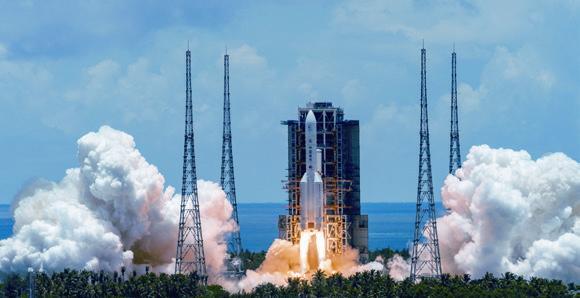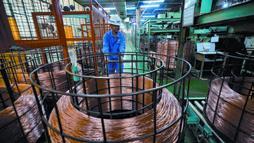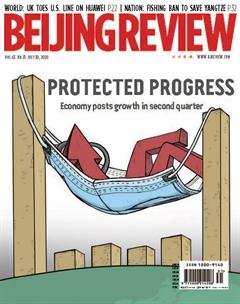MISSION MARS

Chinas fi rst Mars mission blasted off into space on a Long March-5 rocket from the Wenchang Spacecraft Launch Site in Hainan Province, south China, at 12:41 p.m., Beijing time, on July 23.
About 36 minutes later, the spacecraft, including an orbiter and a rover, was sent into the Earth-Mars transfer orbit, beginning an almost seven-month journey to the red planet, according to the China National Space Administration (CNSA).
The missions name Tianwen-1, which means Questions to Heaven, is from a poem by Qu Yuan (about 340-278 B.C.), one of the greatest poets of ancient China. It denotes the countrys pursuit of truth and science and exploring nature and the universe, the CNSA said.

Rescue Ride
People affected by fl ood take a rescue boat to a safe area in Guzhen Town in Luan City, Anhui Province in east China, on July 20. Since July 2, continuous heavy rains have affected more than 3.6 million residents and forced the evacuation of over 600,000 people in Anhui Province.
Criminal Cases
The fi rst half of 2020 saw a decline in the number of criminal cases across China amid the novel coronavirus disease (COVID-19) epidemic, the Supreme Peoples Procuratorate(SPP) said on July 20.
Procuratorates across the country approved or initiated the arrest of 280,333 suspects between January and June, down 47.1 percent from the same period last year, according to the data released by the SPP.
The number of suspects prosecuted in the fi rst six months dropped by 15.9 percent year on year to 673,310, the data showed.
The data also indicated a rise in telecom fraud cases during the same period.
A total of 52,473 telecom fraud suspects were prosecuted from January to June, accounting for 7.8 percent of all suspects prosecuted over the period, up 3.7 percentage points from the same period last year.
Procuratorial organs nationwide have maintained a tough stance against epidemic-related crimes, vowing swift responses with strict punishments.
In the fi rst half of this year, procuratorates approved the arrest of 13 people and prosecuted 80 for impairing infectious disease prevention and treatment, according to the SPP.
Gliders Tested
Haiyan-X, a Chinese underwater glider series, reached a depth of 10,619 meters during a recent mission, breaking its own world record of 8,213 meters, according to its developer.
Xinhua News Agency reported on July 17, two underwater gliders, developed by the Pilot National Laboratory for Marine Science and Technology (Qingdao), registered the results during a fi ve-day survey.
The gliders have reached depths of 10,245 meters, 10,347 meters and 10,619 meters.
Researchers said these depths proved the reliability of the glider series in the deep-sea environment and validated multiple key technologies for underwater gliders.
The unmanned gliders can survey marine conditions, such as temperature, salinity, and currents, in large bodies of water over a long period.
Digital Villages
Chinese authorities have issued a circular on a pilot project to promote the application of digital technologies in rural areas to boost rural modernization, Xinhua reported on July 20.
The circular was jointly issued by seven departments, including the Cyberspace Administration of China, the Ministry of Agriculture and Rural Affairs, and the National Development and Reform Commission.
The pilot project involves overall planning and design of “digital villages,” improvement of newgeneration information infrastructure for participating villages, exploration of new models for rural digital economy and rural governance.
It is expected to see a notable narrowing of the urban-rural digital gap, and rapid development of the digital economy in the pilot villages by the end of 2021, the circular said.
Under the project, the application of optical-fi ber wideband, mobile Internet, digital TV network and next-generation Internet will be accelerated in rural areas.
Public Health
Chinas public health has improved markedly since the launch of a new round of medicine and healthcare system reforms in March 2009, according to an annual report released by the Chinese Academy of Medical Sciences in July.
The average life expectancy rose from 74.8 years in 2009 to 77.3 years in 2019, reads the Development Report on Health Reform in China(2020).
During the same period, the maternal mortality rate dropped from 31.9 per 100,000 to 17.8 per 100,000, while infant mortality fell from 13.8 per 1,000 to 5.6 per 1,000, Xinhua reported on July 20.
There has been a gradual improvement in accessibility and equality of health services in China, with healthcare costs for residents effectively lowered.
The proportion of the overall health expenditure borne by individuals has dropped from 37.5 percent in 2009 to 28.4 percent in 2019, according to the report.
Quarantine Rules
Shanghai will allow people arriving from overseas to undergo a weeklong home quarantine after fi nishing a seven-day concentrated quarantine in designated places starting July 27.
The metropolis in east China previously demanded all overseas arrivals to undergo concentrated quarantine for 14 days in a bid to contain the spread of COVID-19.
The new decision, announced by the citys offi ce on COVID-19 prevention and control, said Shanghaibound travelers can enjoy the new policy if they have a residence in Shanghai and if their living condition fi ts the requirement of at-home quarantine.
They must receive a nucleic acid test before completing seven days of concentrated quarantine and, if their results come back negative, they will be transported to their residence to observe at-home quarantine.
On July 22, Shanghai reported one new imported COVID-19 case and no increase in domestically transmitted cases, the municipal health commission said on July 23.

Wildlife on the Prairie
Tibetan antelopes in a nature reserve in Tibet Autonomous Region in southwest China on July 17.
Clearer Lakes
More than 70 percent of monitored lakes in China witnessed increasing water transparency between 2000 and 2018, which means that lakes in the country became clearer, according to a new study released in July.
The research was based on big data from remote sensing and was jointly conducted by experts from China, Italy, the United States and Britain, Xinhua reported on July 21.
Researchers obtained a large number of satellite images from 2000 to 2018. Combined with fi eld measurements, they developed a new algorithm to calculate the water transparency of Chinas lakes.
The research analyzed monitoring results of 412 lakes, covering most lakes with a water area of more than 20 square km, according to Duan Hongtao, a scientist from the Nanjing Institute of Geography and Limnology, Chinese Academy of Sciences.
The analysis results showed that the water transparency of Chinas lakes is on the rise as a whole. From 2000 to 2018, 289 lakes saw increasing transparency, accounting for 70.15 percent of the total number.
“Increasing water depth, eutrophication control and vegetation restoration in basins are the three main reasons for the improving lake water quality in the country,”Duan said.
In the fi rst half of this year(H1), central SOEs led in work and production resumption, drove the development of all types of market entities and improved production and operation, according to SASAC.
In the January-June period, the combined revenue of the 97 central SOEs fell by 7.8 percent from one year earlier to 13.4 trillion yuan ($1.91 trillion), narrowing by 4 percentage points compared with the decrease in the fi rst quarter.
The central SOEs combined profi ts stood at 438.55 billion yuan($62.6 billion) in H1, down 37.7 percent year on year, narrowing by 12.6 percentage points compared with the decline in the fi rst fi ve months.
E-Seal Application
Chinas fi rst e-seal application platform based on blockchain technology was launched in Hangzhou, Zhejiang Province in east China on July 17, with the aim of boosting security and convenience for enterprises.
With the rapid growth in online government services and ecommerce across China, there is greater demand for e-seals to secure and authenticate documents and transactions.
However, there is little standardization so far, with enterprises and organizations often using different e-seals, authorized by different organizations with various standards. In addition, the use of such e-seals is not traceable.
Such problems have been solved by the launch of the new eseal application platform, developed jointly by Hangzhous data resource administration, market supervision bureau and public security bureau, in cooperation with the Blockchain as a Service of Ant Financial.
The platform will match e-seals with physical seals in a one-to-one correspondence. Each enterprise will need and have only one e-seal.
The use of blockchain technology ensures that the entire e-seal process is traceable, with all data stored safely, and the use of every e-seal authenticated and monitored by multiple parties.

Sea Bounty
Farmers in Qiuzhugang Village boat to harvest oysters in Changchun Township, Fujian Province in southeast China, on July 16. After introducing the popular triploid oysters from Shandong Province in east China, oyster farming has become a new way for local farmers to increase their income. In 2019, the county saw the output value of aquatic products reach 10.3 billion yuan ($1.4 billion).
Booming STAR Market
Chinas Nasdaq-style sci-tech innovation board, also known as the STAR Market, saw a rapid expansion of listed companies in scientifi c and technological sectors including semiconductors and intelligent manufacturing, Economic Information Daily reported on July 20.
Since the board started trading on July 22 last year, the STAR Market has raised over 200 billion yuan ($28.6 billion) for 130 listed enterprises with a total market value of more than 2.42 trillion yuan ($346 billion).
The STAR-listed companies mainly focus on the new generation of the information technology industry, high-end equipment manufacturing and bio-pharmaceutical industry, the newspaper said, citing data from fi nancial information provider Wind Info.
The listed companies showed a fi rm commitment to promoting innovation, with the average investment in research and development accounting for 13 percent of their revenues in the past three years.
According to the newspaper, the STAR board has adopted a slew of institutional innovations since its inception, rendering experience to the A-share market and the pilot registration-based IPO system on the ChiNext stock market, Chinas Nasdaq-style board for growth enterprises.

Welding Impetus
A staff member transfers welding wires at Sino-Japanese joint venture Tangshan Kobelco in Tangshan, Hebei Province in north China, on July 16. The local hi-tech industrial development zone has focused on developing welding industrial clusters, covering the production of welding equipment, welding robots and systems, segmenting facilities and welding materials.
Cargo Transport
Chinas cargo transport industry reported faster growth in June with business activities recovering to normal levels. The China Transportation Services Index (CTSI) stood at 153.9 points in the month, down 11.5 percent year on year, according to the China Academy of Transportation Sciences (CATS).
The decrease narrowed from the 16.5-percent drop recorded in May.
The sub-index for cargo transport jumped 5 percent year on year to 185.2 points in June, a faster growth compared with the 0.8-percent rise in May and reaching almost the same level as that of last year.
Meanwhile, shrinkage in passenger transport further narrowed, with the sub-index of passenger transport down 43.1 percent, narrowing by 6.1 percentage points from May.
With production and daily life restored amid waning novel coronavirus disease (COVID-19) impact, Chinas cargo transport growth is basically back on track, the CATS report said.
The CTSI incorporated the transport volume of passengers and cargo of various transportation means including railways, highways, waterways and civil aviation. With 2010 as the base year and 100 points as the base value, the index includes passenger transport and cargo transport as two sub-indexes.
Power Use
Chinas electricity consumption, a key barometer of economic activity, rose 6.1 percent year on year in June as the impact of the COVID-19 epidemic waned, data from the National Energy Administration(NEA) showed.
According to the NEA, total power use hit 635 billion kWh in June. Specifi cally, power use by the primary and secondary industries rose 12.9 percent and 4.3 percent year on year, respectively, and that by the tertiary industry went up 7 percent from the same period a year ago.
Residential power consumption surged 14.3 percent year on year to 82.5 billion kWh during the period, the NEA said.
In H1 of this year, the power use fell 1.3 percent year on year to 3.35 trillion kWh.
The data came as a string of other economic indicators also showed signs of a rebound on the back of supporting policies to coordinate growth and COVID-19 containment.
Chinas GDP expanded 3.2 percent year on year in the second quarter of 2020, following a 6.8 percent contraction in the fi rst quarter, data from the National Bureau of Statistics (NBS) showed.

E-Commerce Channels
An employee displays how muskmelons are sold via an app at an e-commerce service center in Bachu County in Xinjiang Uygur Autonomous Region in northwest China on July 19. The local government is helping muskmelon farmers sell their fruits via e-commerce platforms.
Boosting Employment
China has slashed social insurance contributions paid by enterprises amid efforts to boost the job market hit by COVID-19 epidemic, offi cials said on July 21.
From February to June, employers saw a decline of 576.9 billion yuan ($82.6 billion) in premiums for insurance related to old age, unemployment and work-related injuries, Zhang Ying, an offi cial with the Ministry of Human Resources and Social Security said.
Besides, insurance premiums worth 63.6 billion yuan ($9.1 billion) were returned to enterprises to help them sustain stable payrolls, while 40.5 billion yuan ($5.8 billion) worth of employment subsidies were handed out, Zhang said.
Nie Mingjun, a ministry offi cial in charge of the pension fund, said the total premium reduction is expected to reach 1.9 trillion yuan ($272 billion) in 2020.
“The cut will be unprecedented in scale,” Nie said. “It will help enterprises rise above diffi culties and ensure further stability and expansion of employment.”
According to the NBS, the surveyed unemployment rate in urban areas stood at 5.7 percent in June, 0.2 percentage point lower than that of May. A total of 5.64 million new urban jobs were created in H1, achieving 62.7 percent of the annual target.
“Employment is steadily recovering, thanks to effective control of the COVID-19 epidemic, steady progress in business and work resumption, as well as economic upturn,” Zhang said.
According to the government work report, this year the aim is to add over 9 million new urban jobs and keep the surveyed urban unemployment rate around 6 percent.

